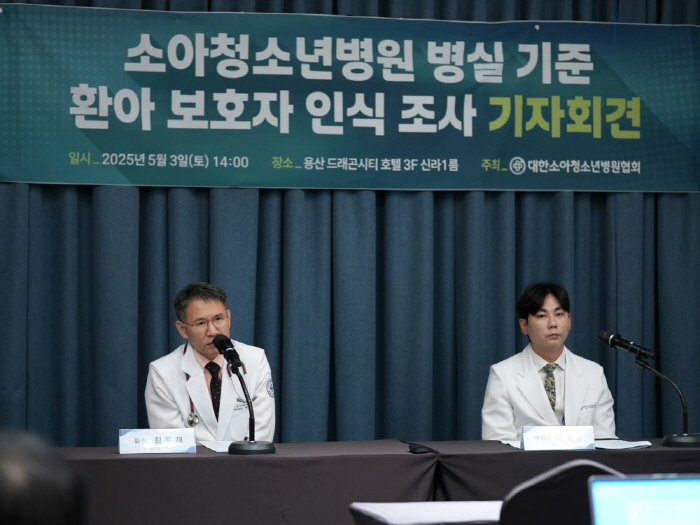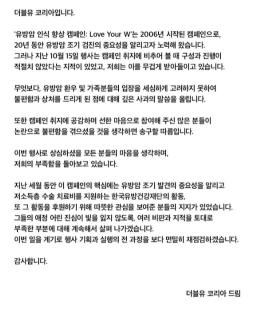I want a patient guardian 96% single room...Due to concerns over cross-infection and invasion of privacy
May 03, 2025
It was found that most guardians of children who visited the pediatric and adolescent hospital prefer to be admitted to a single room due to concerns about cross-infection and invasion of privacy.
This was analyzed in a survey on the perception of pediatric and adolescent rooms for children's carers announced by the Korea Pediatric Youth Hospital Association at a press conference on the 3rd ahead of the 103rd Children's Day on May 5.
Unlike the 8 to 2 ratio of single and multi-room applications in delivery hospitals, the Korea Association of Pediatric and Adolescent Hospitals conducted a survey of child caregivers, including hospitalization for children and adolescents, through QR codes from Nov. 4, 2024, to April 24, 2025, and 2,855 people responded to the survey.
As a result of the analysis, 2743 people answered single rooms when asked which hospital room they prefer, accounting for 96%. Only 112 cases were checked in multiple rooms, including double rooms, at 4%.
When asked why they prefer single rooms, 1,387 people were likely to be infected with other viruses or bacteria (cross-infection), accounting for 49%.
It was followed by 813 people who answered that it was due to all items such as cross-infection and invasion of privacy, which was 28%. Next, there were 634 problems (exposure, noise, invasion of privacy, and friction in life) in the same space with other families, accounting for 22%. The cramped space was 1 percent in 21 cases.
On the other hand, when asked about what they felt when using a multi-person room, they were worried about spreading other infectious diseases, and 2686 people, or 94%. There were 69 (2%) and 100 (4%), respectively, that other infections were not bothered and there were no inconveniences. In order to prevent infection and protect privacy in the Department of Pediatrics and Adolescents, 2737 people were also asked to apply the same standard of 8 single rooms in delivery hospitals, 96%. No was 118, which was only 4%.
Then, 2,741 people (96%) said yes to whether they knew that most of the pediatric and adolescent diseases were infectious diseases. No was 114 (4%).
The proportion of respondents who used multiple rooms was 1948 (70%), and the proportion who did not was 844 (30%).
The hospitalized diseases were pneumonia in the order of 1,741 (61%), enteritis in 247 (9%), flu in 223 (8%), tonsillitis or hand-foot-and-mouth disease, and stomatitis in 178 (6%), corona in 102 (4%), and febrile cramps in the order of 1%. 330 (12%) had no hospitalization experience.
The age group was 1,322 (46%) in their 30s, 1080 (38%) in their 40s, 180 (6%) in their 50s, 174 (6%) in their 20s, 38 (1%) in their teens, 36 (1%) in their 60s, and 25 (1%) in others. The gender was 2,274 (79.6%) in women (mothers) and 581 in men (fathers) (20.4%). For the experience of hospitalizing children, 2525 (88.4%) said yes, and 330 (11.6%) said no.
The number of respondents classified by region was 990 (34.6%), 779 (27.3%) in the Yeongnam region, 662 (23.2%) in the Honam region, and 424 (14.9%) in the Chungcheong region.
At the press conference on this day, Lee Hong-joon, vice president of the Korea Pediatric Youth Hospital (Kimpo Ai Jeil Hospital, head of the Korea Pediatric Youth Hospital), said, `In recent years, various childhood infectious diseases have been prevalent, and complaints from ward carers have continuedThe number of cases of demanding single-person rooms is increasing rapidly despite the lack of single-person rooms, and the difficulties are increasing as front-line pediatric and youth hospitals are struggling to solve this problem, even asking for single-person rooms or allowing the guardian of the child to use only brothers as a way to resolve civil complaints."
Choi Yong-jae, president of the Korea Children's Hospital Association (Head of Strong Children's Hospital in the Medical Government), pointed out that "May 5 marks the 103rd Children's Day, but the day for children is only May 5." "Although the future of Korea is a child, there is still no or no medical policy for children. Therefore, it is necessary to solve problems such as population cliffs through significant improvement and excavation of pediatric medical policies such as standards for pediatric patients' hospital rooms so that 365 days of the year can be Children's Day."," he stressed.
Chairman Choi Yong-jae said "To this end, we need appropriate measures and system improvement for pediatric and juvenile hospitals."On the occasion of the 103rd Children's Day, he suggested that the enactment of the Framework Act on Children's Health that can guarantee children's health rights is most urgent for the future of Korea through children's health.
This was analyzed in a survey on the perception of pediatric and adolescent rooms for children's carers announced by the Korea Pediatric Youth Hospital Association at a press conference on the 3rd ahead of the 103rd Children's Day on May 5.
Unlike the 8 to 2 ratio of single and multi-room applications in delivery hospitals, the Korea Association of Pediatric and Adolescent Hospitals conducted a survey of child caregivers, including hospitalization for children and adolescents, through QR codes from Nov. 4, 2024, to April 24, 2025, and 2,855 people responded to the survey.
As a result of the analysis, 2743 people answered single rooms when asked which hospital room they prefer, accounting for 96%. Only 112 cases were checked in multiple rooms, including double rooms, at 4%.
When asked why they prefer single rooms, 1,387 people were likely to be infected with other viruses or bacteria (cross-infection), accounting for 49%.
It was followed by 813 people who answered that it was due to all items such as cross-infection and invasion of privacy, which was 28%. Next, there were 634 problems (exposure, noise, invasion of privacy, and friction in life) in the same space with other families, accounting for 22%. The cramped space was 1 percent in 21 cases.
On the other hand, when asked about what they felt when using a multi-person room, they were worried about spreading other infectious diseases, and 2686 people, or 94%. There were 69 (2%) and 100 (4%), respectively, that other infections were not bothered and there were no inconveniences. In order to prevent infection and protect privacy in the Department of Pediatrics and Adolescents, 2737 people were also asked to apply the same standard of 8 single rooms in delivery hospitals, 96%. No was 118, which was only 4%.
Then, 2,741 people (96%) said yes to whether they knew that most of the pediatric and adolescent diseases were infectious diseases. No was 114 (4%).
The proportion of respondents who used multiple rooms was 1948 (70%), and the proportion who did not was 844 (30%).
The hospitalized diseases were pneumonia in the order of 1,741 (61%), enteritis in 247 (9%), flu in 223 (8%), tonsillitis or hand-foot-and-mouth disease, and stomatitis in 178 (6%), corona in 102 (4%), and febrile cramps in the order of 1%. 330 (12%) had no hospitalization experience.
The age group was 1,322 (46%) in their 30s, 1080 (38%) in their 40s, 180 (6%) in their 50s, 174 (6%) in their 20s, 38 (1%) in their teens, 36 (1%) in their 60s, and 25 (1%) in others. The gender was 2,274 (79.6%) in women (mothers) and 581 in men (fathers) (20.4%). For the experience of hospitalizing children, 2525 (88.4%) said yes, and 330 (11.6%) said no.
The number of respondents classified by region was 990 (34.6%), 779 (27.3%) in the Yeongnam region, 662 (23.2%) in the Honam region, and 424 (14.9%) in the Chungcheong region.
At the press conference on this day, Lee Hong-joon, vice president of the Korea Pediatric Youth Hospital (Kimpo Ai Jeil Hospital, head of the Korea Pediatric Youth Hospital), said, `In recent years, various childhood infectious diseases have been prevalent, and complaints from ward carers have continuedThe number of cases of demanding single-person rooms is increasing rapidly despite the lack of single-person rooms, and the difficulties are increasing as front-line pediatric and youth hospitals are struggling to solve this problem, even asking for single-person rooms or allowing the guardian of the child to use only brothers as a way to resolve civil complaints."
Choi Yong-jae, president of the Korea Children's Hospital Association (Head of Strong Children's Hospital in the Medical Government), pointed out that "May 5 marks the 103rd Children's Day, but the day for children is only May 5." "Although the future of Korea is a child, there is still no or no medical policy for children. Therefore, it is necessary to solve problems such as population cliffs through significant improvement and excavation of pediatric medical policies such as standards for pediatric patients' hospital rooms so that 365 days of the year can be Children's Day."," he stressed.
Chairman Choi Yong-jae said "To this end, we need appropriate measures and system improvement for pediatric and juvenile hospitals."On the occasion of the 103rd Children's Day, he suggested that the enactment of the Framework Act on Children's Health that can guarantee children's health rights is most urgent for the future of Korea through children's health.
|
This article was translated by Naver AI translator.














